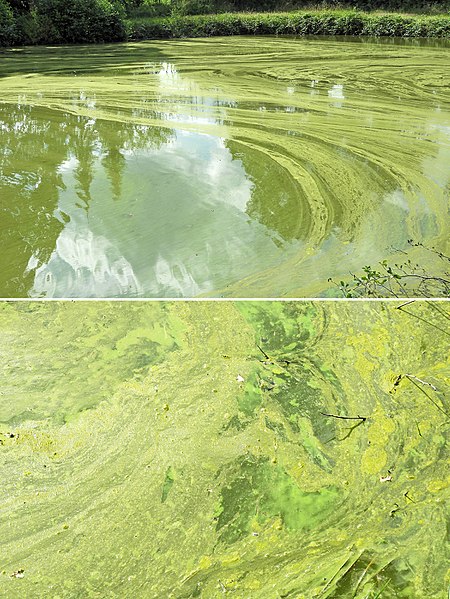When the weather warms up and folks begin to dig out their fishing poles to go drop a line in their favorite pond, I start getting calls about pond weeds. If there’s a thick mat of bubbly yellow-green substance floating on the surface of the pond, or the pond appears to be colored bright green, blue-green, or sometimes even red, then there may be an algae problem. Algal overgrowth is one of the most common issues for pond owners. The first step to effective algae management is to understand what type of algae resides in the pond. There are three different types of algae commonly found in farm ponds and small lakes: planktonic, filamentous, and macroalgae.
Planktonic algae are the microscopic, single-celled, and free-floating algae that exist in the top few feet of a pond or lake where the sunlight penetrates. This type of algae is what gives the water a green coloration. Planktonic algae are normal and are in fact desirable, because they are essential to the pond’s food chain. Planktonic algae provide food for the microscopic animals (zooplankton) that are eaten by minnows, baitfish, and other pond inhabitants, which ultimately support a larger fish population. Planktonic algae are the kinds of algae pond owners actually WANT and the fish NEED! It is important to manage and promote planktonic algae to build good fish populations because they provide food and oxygen for fish. Clear water is not good if pond owners desire a heathy fish population.

Filamentous algae are made of single cells that form long visible chains, threads, and filaments that intertwine to resemble wet cotton or wool. This type of algae grows along the bottom of the pond in shallow areas and then floats to the surface to form bubbly looking mats that can sometimes cover entire ponds. Filamentous algae are frequently referred to as “pond scum” or “pond moss”. Filamentous algae are unsightly and may interfere with swimming, fishing, or other recreational activities, and in rare instances even livestock watering. Aside from aesthetic issues, filamentous algae can also be dangerous for fish. Allowing filamentous algae to accumulate in a pond may lead to early morning fish kills caused by low dissolved oxygen concentrations.
If a pond owner finds a submerged aquatic plant that smells like a skunk or garlic, or feels like it is covered in sand-like grit, they have most likely discovered a macroalgae. Although they may look like it, these are not true vascular or rooted plants. They are a form of multicellular algae called macroalgae that come together to form a structure. Macroalgae have no roots, stems, or true leaves. They are primitive and do not have flowers, fruits, or seeds, but instead produce spores. The two main kinds of macroalgae are Chara or Nitella. These species can be undesirable as a result of their tendency to grow quickly, carpet the bottom of the pond, and crowd out other aquatic plants.
If a pond suffers from algal overgrowth problems, there are several possible approaches to controlling algae. Such methods include biological, physical and chemical controls. Biological controls involve introducing species that prey on algae. Physical control such as raking or seining is another option for filamentous or macroalgae, but it is not a viable approach for planktonic algae due to their microscopic nature. Before discussing the chemical controls that work best for algae, proper identification of the algae and pond management needs to be discussed. If you suspect algae to be a problem, you can contact the Extension Office at 706-795-2281 or clh@uga.edu and we can discuss treatment options.